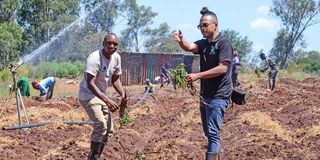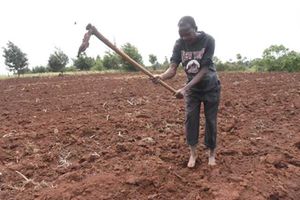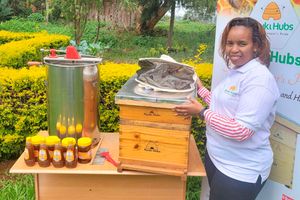
Maina Kamau, the farm manager (left) and Jack Vincent, Founder Zumaridi Farms (right) in one of their farms in Thindigua, Kiambu County on February 14, 2025.
On a hot afternoon in Juja and Thindigua in Kiambu County, the lush green sweet potato vines make an appealing ground cover at Zumaridi Farms. This is considered one of the best high-yielding varieties of sweet potatoes that is drought and virus tolerant: Orange-fleshed sweet potatoes, Irene variety.
With the variety, they employ the right agronomic practices and are in a position to achieve the right market specifications in terms of size, shape and quantities and also the right volumes of between 12 to 15 tonnes of production per hectare compared to four to six tonnes for the ordinary variety.
“We farm the orange-fleshed sweet potatoes in Juja and Thindigua in Kiambu County and in Naivasha, Nakuru County. It is a decision that was informed by the adaptability nature of the crop as it can be grown in a variety of agro ecological zones and is one that fits in the export market,” Jack Vincent, founder of Zumaridi Farms says.
Tuber formation, according to farm manager Maina Kamau, is crucial and for one to get the required size and shape the process starts from ploughing all the way to harvesting. “If you miss a point in between you lose the entire produce, an aspect that necessitates one to be very careful in all the stages,” he says.
To realise full potential at the farm, all the preparations, planting methods and good agronomic practices are observed. First, the land is prepared adequately by ploughing and removing weeds and trash while incorporating organic matter so as to improve the soil fertility. Deep soils that are free from hard pans are guaranteed and proper spacing between plants for optimum growth and yield is ensured.
“We do primary and secondary ploughing followed by harrowing. We then make ridges (75cm apart and at least 45cm deep). Depth determines the shape of the tuber as the market requires a firm, straight with a uniform taper from shoulder to tip,” he says.
The farm assumes a spacing of between 75-100cm ridge to ridge and 10cm from one vine to the other. This creates optimum utilisation of nutrients and promotes formation of the right specs. In further ensuring quality produce and guaranteeing quality produce, the farms source their planting materials/vines from the Kenya Plant Health Inspectorate Service and also from certified propagators.
“We have to ensure that we have clean certified disease-free vines that are high yielding. We also treat the vines with disinfectants to keep pests and diseases at bay,” Maina says. “Lack of access to quality planting materials can lead to pests and diseases and this hinders farmers’ ability to access international markets, which require high quality produce. The vines obtained should be healthy and vigorous to guarantee maximum tuber production.”
In getting the right produce, the farm further uses vine cuttings instead of roots as they are considered free from soil borne diseases. The vines used are not more than three generations old from the original certified seedlings.
In ensuring that the farm is well watered the management opted for overhead irrigation so as to ensure consistent soil moisture throughout the growing season. “We keep monitoring the soil moisture levels regularly as proper irrigation management is critical for the sweet potatoes; they require adequate water to support their growth yield and quality,” he says.
Kamau further advocates for crop rotation to minimise diseases and pest build up while working to enhance the soil health in an effort to optimise overall farm production.
“Farmers may rotate their sweet potato plantations with other crops that have different nutrient requirements. Orange-fleshed sweet potato should never be followed by a root say cassava, yam or tubers as they have almost similar nutrient requirements. The variety can either be followed by a cereal like maize, sorghum or rice or even a legume such as fine beans and onions, a desirable way to control diseases and pests,” he says.
Regular field monitoring is also highly effected where diseased plants are gotten rid of so as to eliminate vectors carrying diseases, bacteria, fungi or viruses.
In determining whether the tubers are mature or not, the management checks on some of the following indicators: the yellowing of the leaves, drying of vines, cracking of ridge and checking on the colour of the latex exudation as latex from mature tubers remain creamy white, while latex from immature tubers when cut turns black. Harvesting is done using blunt objects so as to loosen the soil and gently lift up the tuber.
According to Kamau, “Harvesting must be timely as when the crops are left too long in the ground they are prone to rotting and weevil attack which can cause havoc to the entire produce,” he says.
The farm sells both in retail and wholesale markets with prices ranging between Sh50 to Sh100 per kilogramme. The price depends on demand and supply forces, quantities ordered and nature of the order (cured or uncured).
They also do curing as a way of adding value, where after harvest, tubers are put in a special facility at a temperature of 28 degrees centigrade to 31 degrees centigrade with a high relative humidity (80-90 per cent) for five to seven days. After curing, the tubers become sweeter and attain a deep orange colour. “Curing also increases the post-harvest life. Sweet potatoes will keep for several months without losing any nutritional value,” he says.
In advocating for the variety, Kamau says that it is unique in that it matures fast at three to four months, has a high level of Beta Carotene (a precursor of vitamin A), which can be used to fight Vitamin A deficiency.
One key advantage of the venture is that the sweet potatoes are not prone to pests and disease attack, and if any, regular watering and weed free fields keep pests and disease at bay. The variety has many uses and can be boiled, fried, baked, mashed or in making flour.






